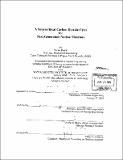A supercritical carbon dioxide cycle for next generation nuclear reactors
Author(s)
Dostal, Vaclav, 1976-
DownloadFull printable version (12.84Mb)
Other Contributors
Massachusetts Institute of Technology. Dept. of Nuclear Engineering.
Advisor
Michael J. Driscoll.
Terms of use
Metadata
Show full item recordAbstract
A systematic, detailed major component and system design evaluation and multiple parameter optimization under practical constraints has been performed of the family of supercritical CO2 Brayton power cycles for application to advanced nuclear reactors. The recompression cycle is shown to excel with respect to simplicity, compactness, cost and thermal efficiency. The main advantage of the supercritical CO2 cycle is comparable efficiency with the helium Brayton cycle at significantly lower temperature (550⁰C vs. 850 ⁰C), but higher pressure (20 MPa vs. 8 MPa). The supercritical CO2 cycle is well suited to any type of nuclear reactor with core outlet temperature above [approx.] 500 ⁰C in either direct or indirect versions. By taking advantage of the abrupt property changes near the critical point of CO2 the compression work can be reduced, which results in a significant efficiency improvement. However, a real gas cycle requires much more careful optimization than an ideal gas Brayton cycle. Previous investigations by earlier authors were systematized and refined in the present work to survey several different CO2 cycle layouts. Inter- cooling, re-heating, re-compressing and pre-compressing were considered. The recompression cycle was found to yield the highest efficiency, while still retaining simplicity. Inter-cooling is not attractive for this type of cycle as it offers a very modest efficiency improvement. Re-heating has a better potential, but it is applicable only to indirect cycles. Economic analysis of the benefit of re-heating for the indirect cycle showed that using more than one stage of re-heat is economically unattractive. (cont.) For the basic design, turbine inlet temperature was conservatively selected to be 550⁰C and the compressor outlet pressure set at 20 MPa. For these operating conditions the direct cycle achieves 45.3 % thermal efficiency and reduces the cost of the power plant by [approx.] 18% compared to a conventional Rankine steam cycle. The capital cost of the basic design compared to a helium Brayton cycle is about the same, but the supercritical CO2 cycle operates at significantly lower temperature. The current reactor operating experience with CO2 is up to 650⁰C, which is used as the turbine inlet temperature of an advanced design. The thermal efficiency of the advanced design is close to 50% and the reactor system with the direct supercritical CO2 cycle is - 24% less expensive than the steam indirect cycle and 7% less expensive than a helium direct Brayton cycle. It is expected in the future that high temperature materials will become available and a high performance design with turbine inlet temperatures of 700⁰C will be possible. This high performance design achieves a thermal efficiency approaching 53%, which yields additional cost savings. The turbomachinery is highly compact and achieves efficiencies of more than 90%. For the 600 MWth/246 MWe power plant the turbine body is 1.2 m in diameter and 0.55 m long, which translates into an extremely high power density of 395 MWe/m3. The compressors are even more compact as they operate close to the critical point where the density of the fluid is higher than in the turbine. The power conversion unit that houses these components and the generator is 18 m tall and 7.6 m in diameter. Its power density (MWe/m3) is about 46% higher than that of the helium GT-MHR ...
Description
Thesis (Sc. D.)--Massachusetts Institute of Technology, Dept. of Nuclear Engineering, 2004. Includes bibliographical references (p. 309-314).
Date issued
2004Department
Massachusetts Institute of Technology. Department of Nuclear Engineering; Massachusetts Institute of Technology. Department of Nuclear Science and EngineeringPublisher
Massachusetts Institute of Technology
Keywords
Nuclear Engineering.